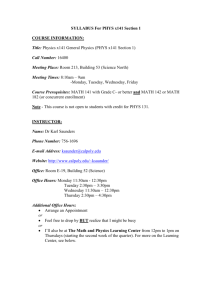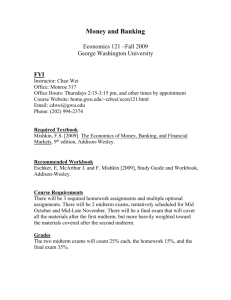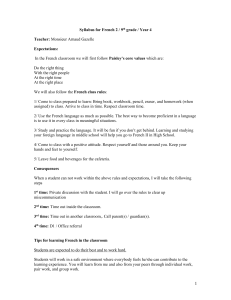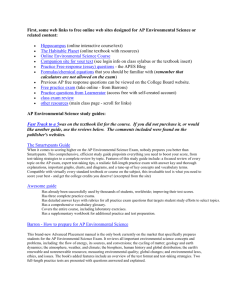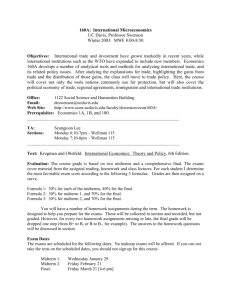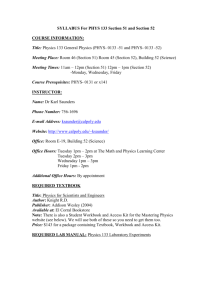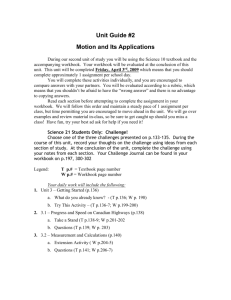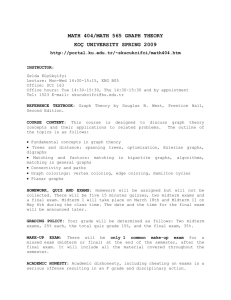Physics 141: NAME
advertisement
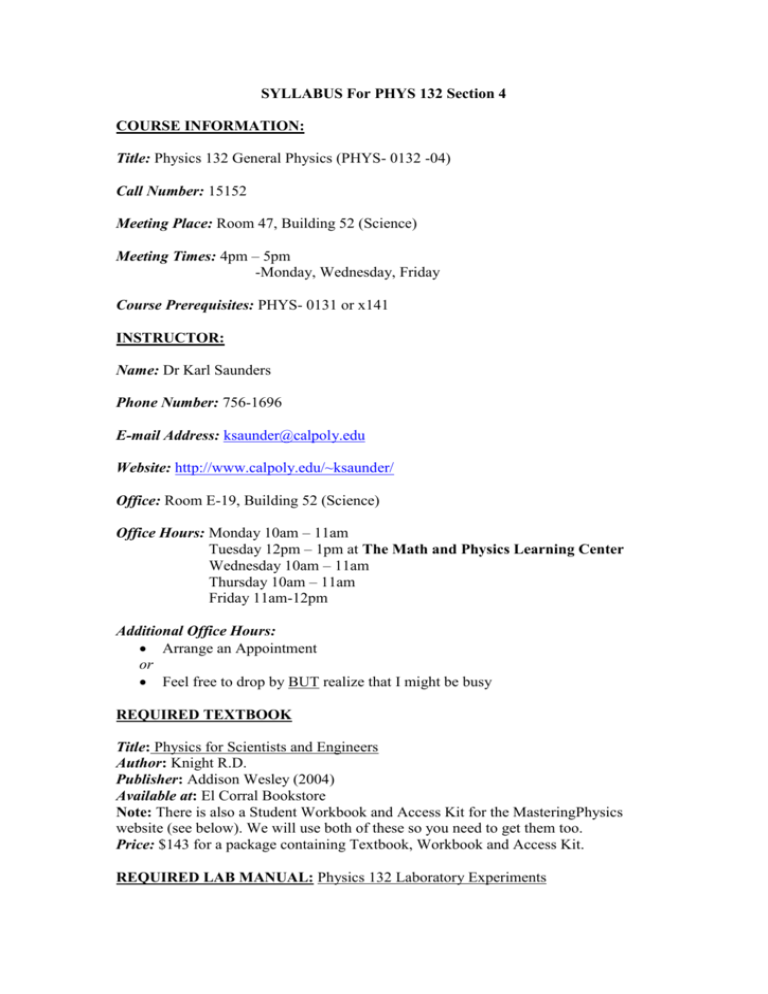
SYLLABUS For PHYS 132 Section 4 COURSE INFORMATION: Title: Physics 132 General Physics (PHYS- 0132 -04) Call Number: 15152 Meeting Place: Room 47, Building 52 (Science) Meeting Times: 4pm – 5pm -Monday, Wednesday, Friday Course Prerequisites: PHYS- 0131 or x141 INSTRUCTOR: Name: Dr Karl Saunders Phone Number: 756-1696 E-mail Address: ksaunder@calpoly.edu Website: http://www.calpoly.edu/~ksaunder/ Office: Room E-19, Building 52 (Science) Office Hours: Monday 10am – 11am Tuesday 12pm – 1pm at The Math and Physics Learning Center Wednesday 10am – 11am Thursday 10am – 11am Friday 11am-12pm Additional Office Hours: Arrange an Appointment or Feel free to drop by BUT realize that I might be busy REQUIRED TEXTBOOK Title: Physics for Scientists and Engineers Author: Knight R.D. Publisher: Addison Wesley (2004) Available at: El Corral Bookstore Note: There is also a Student Workbook and Access Kit for the MasteringPhysics website (see below). We will use both of these so you need to get them too. Price: $143 for a package containing Textbook, Workbook and Access Kit. REQUIRED LAB MANUAL: Physics 132 Laboratory Experiments RESOURCES The Math and Physics Learning Center: If you are having trouble with the homework or understanding the concepts, the physics learning center will be open 25 hours a week. It is located in Room A03 in Building 52 (Science). A math professor, a math student, a physics professor, and a physics student staff the learning center. The hours are Monday to Friday 9am - 2pm, starting the second week of each quarter. Web Resources: My Personal Website http://www.calpoly.edu/~ksaunder/ This website contains a link to my Phys 132 website that will include the syllabus, homework assignments and solutions as well as announcements MasteringPhysics Website: http://www.masteringphysics.com This is an online tutorial and homework and system run by the publisher of our textbook. You can access it using the Access Kit that came with your book- there is an Access Code on the inside cover of the kit. The kit also contains a Getting Started booklet that you should read. I am also giving you a handout called “Using MasteringPhysics” that contains useful information, including how to register the first time. We will be using this website for doing homework so please get comfortable with it as soon as possible. COURSE FORMAT: CLASS MEETINGS: I will lecture using the blackboard. As often as possible we will work together on problems and exercises from the student workbook so bring paper, pen/pencil, calculator and the student workbook. I will try to let you know in advance whether I anticipate using the workbook or not so you don’t bring it needlessly. I will assign reading from the textbook in advance of each class In the calendar below I list the chapters I plan to cover each week. In each class I will tell you what I plan to cover the next day so you can read in advance. This is important because I will not always cover everything in class. You are responsible for covering the material by reading. Classroom behavior: We should all expect behavior in the classroom that is considerate of everyone else in the classroom. This covers a lot of different things but includes not eating/ drinking or reading the newspaper. It also means we (including me) should turn our cell phones off. If you need to take a call then leave the classroom and don’t come back until the next time we meet. If people are getting up and coming back in it is distracting for us all. Attendance: It is very important to attend every class – the quarter system moves quickly. A big part of not falling behind means attending all of the classes. I am going to reward good attendance through out the quarter with extra credit (2%). I’ll take attendance each day and if you arrive late you will be marked absent. If you miss no more than 2 classes you will receive all the extra credit (2%). If you miss only three classes you’ll receive half the extra credit (1%). If you miss more than three classes then you’ll receive no extra credit. There are no excused absences (unless exceptional) so save the two allowed absences for unexpected difficulties such as when you feel too sick to attend class, or for out of town athletic events you participate in, etc. LABORATORY: The laboratory is an integral part of this course and will support the material covered in lecture. You must be concurrently enrolled in the laboratory. The lab should be thought of as an extension of the lecture as some of the material is better presented in lab than in lecture. The lab itself will contribute toward your grade only for borderline grade decisions – but you must pass the lab to pass the course. HOMEWORK Working on homework is an absolutely crucial aspect of this course. It will test to see if you understand the material presented and, equally importantly, it will help you to develop the skills of model building, critical thinking and problem solving. The exams I give will contain questions similar to those you receive for homework so it is also in your interest to work hard on the homework if you want to do well on the exams. I may even use some of the homework problems for exam problems! A (tentative, i.e., subject to change) list of the homework problems that I will give each week is given in the schedule. At the end of each class I will assign you the homework problems you should be ready to tackle. At the same time I will also announce the due date for this homework. In all cases late homework will not be accepted. The solutions will be posted online on my personal website (see above). You are to do the homework carefully and clearly on paper. You are also to submit it Mastering physics. Half the points for each problem will be awarded for the answer you submit to Mastering Physics – WAY 1. The other half will be awarded for how you presented the solution on paper – WAY 2. WAY 1: Using the Mastering Physics (MP) Website (see above) You’ll log on to the MP website using your login and password. Here you’ll see a list of the problems I want you to do. The deadline will appear at the top of the screen. The computer has no mercy with regard to the deadline. It stops giving credit at exactly this time. Half the points for each problem will be awarded for the answer you submit to Mastering Physics. WAY 2: Handwritten and turned in to me. Put only one problem per page. Clearly label the problem number, date and your collaborators (see below) at the beginning of each problem. Keep all of your homework together and organized - use a ring binder. This will help you when you are studying for exams. If you come to my office with a question on a homework problem bring the binder with you so I can see your approach to the problem. I will only answer your question if you have your ring binder and attempted solution. Half the points for each problem will be awarded for how you presented the solution on paper. Collaboration: You can work on problems (or study) individually or in groups. Collaboration is an important aspect of everyday life and develops teamwork and communication skills. You are to name your collaborators at the start of each homework problem. A few words of advice, however: It is a good idea to think about the problem by your self first. You may find that for a particular problem collaboration isn’t necessary. If collaboration is necessary then you will make it more productive by knowing what you do and don’t understand about the problem before collaborating. If you collaborate on and solve a problem you must make sure that you, individually, understand how the solution is reached. A good way to check this is to try the problem again by yourself and without looking at the solution. The exams will consist of problems similar to those from homework. It is better to make sure you understood the solution while doing homework than to realize you didn’t during the exam! If you are having difficulty with the homework (or other) problems you can bring your question to: Class My office The Physics Learning Center (see above) A classmate Student Workbook: There is a Student Workbook in addition to the Textbook. It consists of short exercises that are nearly all qualitative rather than quantitative. They don’t involve significant calculation and are basically there to give you a chance to practice the ideas and techniques that you’ll learn from the textbook and class. As often as possible we’ll work on exercises during class. “Study: 25-35 Hours/Week”: You have all seen the “Study 25-35 Hours/Week – 2 hours /unit/week” signs around campus. This class is four units so you should be studying at least 8 hours for it. “Studying” includes (but is not limited to): Reading Doing exercises from the workbook Doing the homework problems Preparing for exams THINKING about the concepts Studying isn’t just reading and memorizing. If it was, there is no way I could study 25-35 hours a week. The great thing about taking a physics class is that a lot of the “study” is problem solving. You learn a lot of the physics through being challenged by problems, not just reading the textbook. It’s kind of like learning vocabulary by doing crosswords instead of just reading a dictionary - which sounds more fun to you? Studying 8 hours a week (at least) for this course may seem a lot but remember that the studying takes many forms and you’ll be surprised how quickly time will fly when working on problems. EXAMS There will be two midterm exams and a final exam. The exams will include both problems to set up and/or solve and conceptual questions in the material. The dates are given in the schedule. They are: Midterm 1: In class Friday January 28th (end of Week 4) Midterm 2: In class Friday February 18th(end of Week 7) Final Exam: Tentative Date is Tuesday March 15th 7th 7:10pm- 10pm. Location to be announced. This is a common final for all of the sections of Phys 132 that I’ll be teaching. The final exam is comprehensive. If you fail the final you will fail the course. If you have to miss an exam, then arrangements must be made before the exam is given. If there is a test day emergency or illness, then leave me a message at my office (7561696) BEFORE THE TEST. Then make arrangements with me as soon as possible. PARTICIPATION It is very important that you are active in the course beyond doing homework, exams and being a warm body in a desk. I will reward good participation with up to 3% extra credit. Participation will include bringing the workbook so you can do workbook exercises, doing the reading so you can contribute to discussion. The best way to participate is to ASK QUESTIONS. It makes the class more interesting, engaging and fun for me and- more importantly- you! You can ask questions or make a comment: If there is something you don’t understand Something I didn’t explain well If you notice something interesting If you think I made a mistake (I guarantee I will at some stage) If you want to catch me out If you want me to hear a voice other than mine ANYTHING ELSE (!!!) relevant to the class If you are shy there are ways to participate other than speaking up in class. You can come by my office for a chat about something you don’t understand, something I didn’t explain well, something you find interesting or anything else. You can email me too. Basically I want you to interact with me. This will help me get a sense of how you are doing and how I am doing. Learning isn’t just about one person shoveling information to the other. It is more rewarding when it is an interactive process and a two way street. GRADING Homework: 20% Midterm 1: 20% Midterm 2: 20% Final: 40% Extra Credit for Attendance: 2%; Extra Credit for Participation: 3% WHAT ARE WE GOING TO LEARN ABOUT? The second course in the General Physics sequence. This course extends the ideas of Newton's laws and energy concepts to: Oscillations and waves, including sound Light, geometrical optics, interference and diffraction Heat and temperature, the thermal properties of materials and the principles of thermodynamics. It is almost like three short courses, rather than the continuous thread of related topics that was encountered in Phys 131/141. If the first course in the sequence dealt with the motion of objects - either single particles or collections of particles that can be treated as single objects (like balls or blocks), this course can be thought of as dealing with the collective motion of systems of particles. Wave motion is a further extension of the ideas in which we’ll describe the motion of "disturbances”. The ideas of wave motion will be applied to light - with analogies to the discussion of sound being made where appropriate. Liquids and gases are interacting systems of huge numbers of particles - but can be understood as systems without knowing how individual particles behave. All thermodynamic processes are ultimately related to the microscopic motions of the atoms that make up the objects or systems being described. COURSE OBJECTIVES An active participation in this introductory course physics should yield: 1. An understanding of the basic laws of nature relating to oscillations, wave motion, sound, and interference; heat and thermodynamics; and the ideas of both geometrical and physical optics. 2. An ability to explain, set up, and solve basic problems involving oscillatory systems, resonance, wave motion and sound, interference; geometric optics including light, mirrors, lenses, and interference and diffraction; and thermodynamic processes, heat transfer, heat engines. 3. A basic understanding of the interplay between theory and experiment in building our understanding of how the universe works - in particular how that relationship applies to the laboratory experience. 4. The ability to make physical measurements in the laboratory, interpret those measurements, and compare the results with those expected based on theory, and to then draw conclusions and report on what you find. APPROXIMATE SCHEDULE: HARMONIC OSCILLATIONS, WAVE MOTION, SOUND (About 4 weeks) Oscillatory motion - Mass/spring systems, pendula, damped oscillations and resonance. Transverse and longitudinal waves, interference of waves, standing wave resonances. Sound as an example of wave motion, sound intensity and sound level, Doppler effect. Midterm 1 will cover this material. WAVE OPTICS AND GEOMETRICAL OPTICS (About 3 weeks) Properties of light, wave optics, interference and diffraction. Geometrical optics including Snell's law of refraction, lenses and image formation with lens systems. Midterm 2 will cover this material THERMODYNAMICS (About 43weeks) Pressure, temperature, calorimetry, and thermal properties of solids, liquids, and gases. Work, heat, and internal energy - the First Law of Thermodynamics The macro/micro connection - Entropy and the Second Law of Thermodynamics Thermodynamic processes in ideal gases; Heat engines and thermodynamic efficiency. Final Exam: Tentative Date is Tuesday March 15th 7th 7:10pm- 10pm. Location to be announced. This is a common final for all of the sections of Phys 132 that I’ll be teaching.
